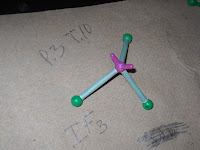Introduction:
In this reaction lab we had a single displacement reaction that was going on which involved 3CuSo4 + 2 Al which combined with aluminum would form 3Cu + Al2(So4)3 since aluminum is a more active metal than copper it therefore switches place with copper in the reaction and our product then was copper. The limiting reactant is aluminum because in the reaction it is consumed completely. In the lab we had also used aluminum powder which in turn created more surface area in the reaction and caused it to go faster. We can identify that it is a chemical change due to the fact that a precipitate was formed and that there was a color change that took place. In the lab we had also calculated our theoretical, actual and percent yield.
.8gAl * 1 mol Al/26.98mol Al * 3 mol Cu/2 Mol Al * 9 g Cu/ 1 mol Cu=2.83 grams of Cu
our theoretical yield, which is the maximum amount of product given from an amount of reaction , was .9 and our actualy yield, the amount actually produced, is 2.72 gave us a percent yield of 46.46%. The percent yield was to accurately show the real amount of copper given off from the reaction.

List of materials
- Scale
- propane
- Beaker
- CuSO4 * 5H2O
- Bunsen Burner
- Aluminum powder
- Filter paper
- funnel
- Medium sized beaker
- add 75 to 100 ml of water to the beaker.
- Measure out .7 and 1g of CuSO4*5H2O
- Stir the solution until the CuSO4 is dissolved
- Weigh out a piece of paper.
- Stir frequently allow the reaction to occur until you cant see any more silvery foil pieces.
- filter out solution then allow to dry for a day
- weighed the copper in the filter paper
- then found percent yield, actual and theoretical yield
| Aluminum & Copper (II) Sulfate Redox Lab | |
| Substance | Mass (grams) |
| Cu2SO4●5H2O | |
| Al dust | |
| Filter paper | |
| | |
the purpose of this lab was to find out the percent yield with the given amount of solution and material. to find out how much of one substance you will get from another after the process
conclusion
The steps we took were to help us find the percent yield. The percent yield is found to show us how much of an element will come from a solution. This in turn can help us in many ways. Air bags for example can save our lives.




















